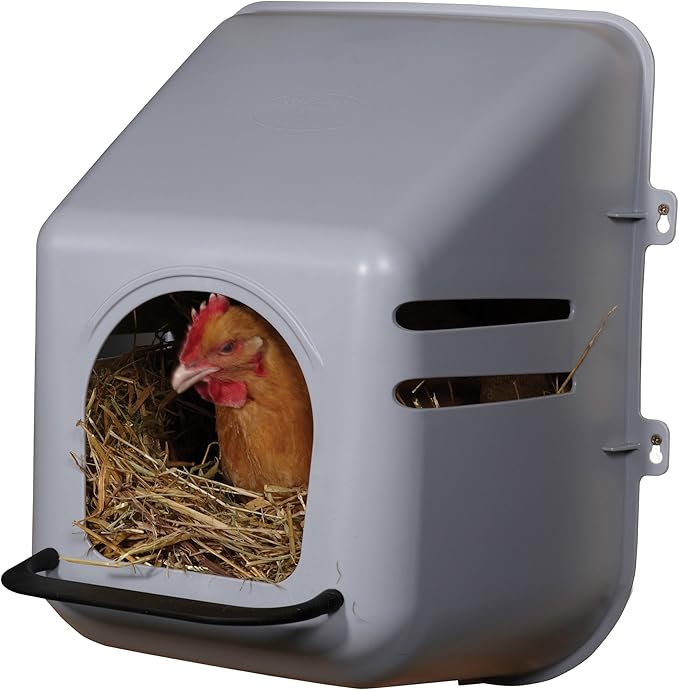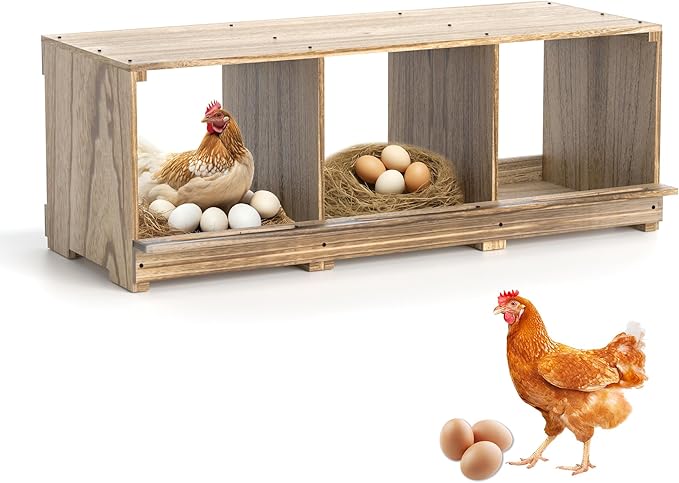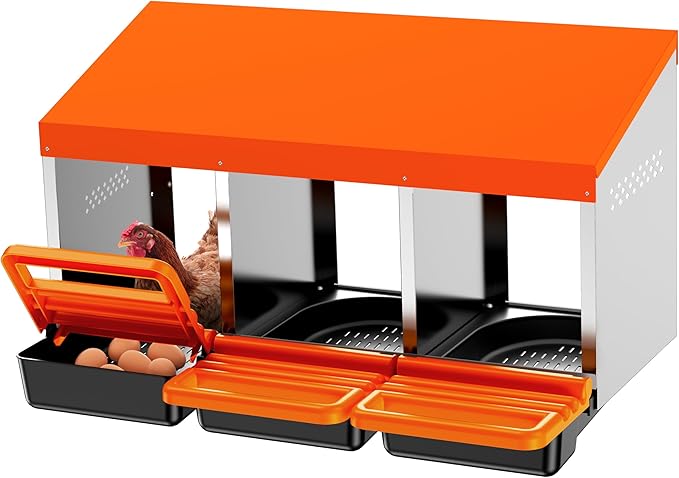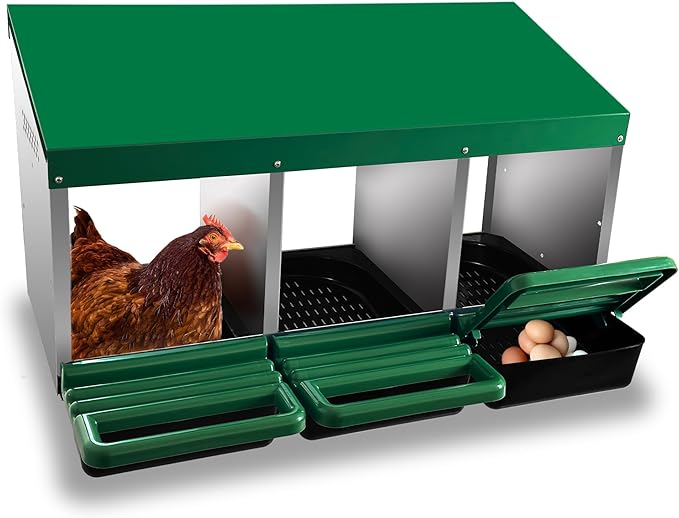Wall Mounted vs Roll Away Chicken Nesting Boxes: Which is Best for Your Flock?

Long-time chicken keepers, have grappled with the nesting box dilemma more times than can be counted. After years of experience and countless conversations with poultry enthusiasts, I’m excited to share my insights to help you make the best choice for your birds.
Understanding Nesting Box Basics
Nesting boxes are the cornerstone of any well-designed chicken coop. They provide a safe, comfortable space for hens to lay their eggs, playing a crucial role in egg production, chicken behavior, and overall flock management.
The right setup can significantly impact egg quality, cleanliness, and your daily chicken-keeping routine.
The Science Behind Chicken Nesting Behavior
Chickens have retained many of their wild instincts, including the drive to seek out secluded, dark spots for egg-laying. This behavior, deeply rooted in their genetic makeup, serves to protect their offspring from predators and harsh environmental conditions.
By understanding and accommodating these instincts, we can create nesting environments that promote both hen comfort and optimal egg production.
Key Factors Influenced by Nesting Box Design
- Egg Production Rates: A comfortable, stress-free nesting area encourages consistent laying.
- Egg Cleanliness and Quality: Proper design helps keep eggs clean and reduces the risk of breakage.
- Hen Stress Levels: A well-designed nesting area minimizes competition and promotes calm behavior.
- Flock Dynamics: Adequate nesting space helps prevent squabbles and maintains social harmony.
- Ease of Egg Collection: The right setup can save you time and effort in your daily chicken-keeping tasks.
Wall Mounted Nesting Boxes: The Traditional Choice
Wall mounted nesting boxes have been a staple in chicken coops for generations, and for good reason. Their simplicity and effectiveness make them a popular choice for backyard flocks and small-scale operations.
Advantages of Wall Mounted Boxes
- Cost-Effective: Generally less expensive to build or purchase than roll away systems.
- Simple Installation: Can be easily attached to existing coop walls with basic tools and skills.
- Customizable: Easily adapted to fit different coop layouts and chicken breeds.
- Familiar to Chickens: Hens typically take to these boxes quickly, as they mimic natural nesting spots.
Potential Drawbacks
- Manual Egg Collection: Requires daily (or more frequent) visits to gather eggs.
- Cleaning Challenges: Can be more time-consuming to clean thoroughly, especially in larger setups.
- Egg Damage Risk: Hens may accidentally break eggs when entering or exiting the box.
- Encourages Broodiness: The constant presence of eggs may trigger broody behavior in some hens.


Roll Away Nesting Boxes: A Modern Approach
Roll away nesting boxes represent a more recent innovation in chicken keeping. These systems feature sloped floors that gently guide freshly laid eggs into a separate collection area, offering several unique benefits.
Advantages of Roll Away Systems
- Automated Egg Collection: Eggs roll into a protected area, reducing the frequency of coop visits.
- Improved Egg Cleanliness: Less contact with hens and nesting material keeps eggs cleaner.
- Reduced Egg Eating: By quickly removing eggs from the nesting area, this behavior is discouraged.
- Easier Cleaning: Many models feature removable trays for quick and thorough cleaning.
Potential Drawbacks
- Higher Initial Cost: More complex design typically means a higher upfront investment.
- Learning Curve: Some hens may need time to adjust to the new nesting environment.
- Maintenance Requirements: Moving parts may need occasional repairs or replacements.
- Space Considerations: These systems often need more room than traditional wall mounted boxes.


As an amazon associate I may receive a commission on eligible purchases at no extra cost to you.
Choosing the Right System for Your Flock
The decision between wall mounted and roll away nesting boxes depends on several factors unique to your situation. Consider the following when making your choice:
Flock Size
For small backyard flocks (under 20 hens), wall mounted boxes often suffice. Larger flocks or commercial operations may benefit more from the efficiency of roll away systems.
Time and Labor Constraints
If you’re short on time for daily egg collection and cleaning, roll away boxes can be a game-changer. However, if you enjoy frequent interaction with your flock, wall mounted boxes might be preferable.
Budget Considerations
Wall mounted boxes are generally more budget-friendly, especially for those willing to build their own. Roll away systems represent a larger initial investment but can save time and labor in the long run.
Coop Design and Space
Evaluate your coop’s layout and available space. Wall mounted boxes can be adapted to fit most spaces, while roll away systems may need specific configurations.
Chicken Breeds
Some breeds are more adaptable to roll away systems than others. Heavier breeds or those prone to broodiness might prefer traditional wall mounted boxes.
Implementation Guide: Wall Mounted Nesting Boxes
Setting up wall mounted nesting boxes needs careful planning and execution. Follow these steps for a successful installation:
- Location Selection: Choose a quiet, dark area of the coop, ideally 18-24 inches off the ground.
Avoid high-traffic areas or spots directly under roosts.
- Box Sizing: For standard chicken breeds, aim for boxes about 12x12x12 inches.
Adjust sizes for larger or smaller breeds as needed.
- Materials: Use sturdy, easy-to-clean materials like wood or plastic.
Ensure all surfaces are smooth to prevent injury.
- Installation: Securely attach boxes to the coop wall using strong screws or bolts.
Check for stability before use.
- Bedding: Line the bottom of each box with 2-3 inches of clean, dry nesting material such as straw, wood shavings, or specialized nesting pads.
- Encouraging Use: Place ceramic eggs or golf balls in the boxes to show hens where to lay.
Some keepers find success with herbs like lavender to attract hens to the nesting area.
Implementation Guide: Roll Away Nesting Boxes
Installing roll away nesting boxes needs a bit more planning and precision. Here’s how to set up your system effectively:
- System Selection: Choose a roll away system that fits your coop size and flock needs. Consider factors like ease of cleaning and egg collection.
- Location Planning: Decide on the best spot for easy access to the egg collection area.
Ensure the system can be securely mounted and level.
- Installation: Follow manufacturer instructions carefully.
Pay special attention to the slope angle – it should allow eggs to roll gently without damage.
- Collection Area Setup: Ensure the egg collection area is easily accessible and protected from light and heat.
Some keepers add padding to cushion eggs as they roll.
- Nesting Material: Use specialized roll away nesting pads or a thin layer of bedding that won’t interfere with the egg’s movement.
- Hen Training: Introduce hens to the new boxes gradually.
Use treats to encourage exploration and place them in the nesting area during the adjustment period.
Maintenance and Troubleshooting
Regardless of the system you choose, proper maintenance is key to long-term success. Here are some tips for keeping your nesting boxes in top condition:
Daily Tasks
- Collect eggs regularly, at least once a day.
- Check for and remove any broken eggs or soiled nesting material.
- Ensure all hens have access to nesting areas, addressing any bullying or overcrowding issues.
Weekly Tasks
- Perform a thorough cleaning of all nesting boxes.
- Replace bedding material or wash nesting pads.
- Inspect boxes for signs of wear, damage, or pest infestation.
Monthly Tasks
- Conduct a deep clean of the entire nesting area.
- Check and tighten any loose screws or fittings.
- Evaluate the system’s effectiveness and make adjustments as needed.
Troubleshooting Common Issues
- Hens Laying on the Floor: Add more nesting boxes or make existing ones more attractive with fresh bedding and ceramic eggs.
- Egg Eating: Collect eggs more often or consider switching to roll away boxes if this behavior continues.
- Overcrowding: Ensure you have at least one nesting box for every 4-5 hens.
Add more boxes if needed.
- Broody Hens: For wall mounted boxes, regularly remove eggs to discourage broodiness.
In roll away systems, confirm the collection area is inaccessible to hens.
- Dirty Eggs: Improve coop ventilation, adjust nesting material, or consider switching to a roll away system for cleaner eggs.
Advanced Nesting Box Strategies
As you become more experienced with chicken keeping, you might want to explore some advanced nesting box techniques:
Automated Systems
For large flocks or commercial operations, fully automated egg collection systems can significantly reduce labor. These systems use conveyor belts or air-assisted methods to transport eggs from nesting boxes to a central collection point.
Climate Control
In extreme climates, consider adding insulation or even small heating or cooling elements to nesting boxes. This can help maintain egg quality and encourage consistent laying during temperature extremes.
Smart Monitoring
Integrate sensors and cameras into your nesting box setup to track laying patterns, watch hen health, and alert you to any issues in real-time.
Custom Designs
Experiment with unique nesting box designs tailored to your specific needs. This might include multi-level systems, boxes with privacy curtains, or designs that facilitate easier cleaning and maintenance.
Adapting Your Nesting Box Strategy
Your nesting box needs may evolve over time. Be prepared to adapt your setup as circumstances change:
- Seasonal Adjustments: Add extra insulation to wall mounted boxes in winter or improve ventilation in summer.
- Flock Changes: As your flock grows or shrinks, be ready to add or remove nesting boxes accordingly.
- Breed-Specific Needs: If you introduce new chicken breeds, you may need to adjust box sizes or styles to accommodate them.
- Production Goals: If you decide to scale up egg production, consider transitioning from wall mounted to roll away systems for increased efficiency.
Key Takeaways
- Wall mounted boxes offer simplicity and cost-effectiveness, ideal for small to medium flocks.
- Roll away systems can improve egg cleanliness and collection efficiency, especially for larger operations.
- Consider your flock size, budget, available time, and management style when choosing a nesting box system.
- Proper installation, maintenance, and regular cleaning are crucial for the success of any nesting box setup.
- Be prepared to adapt your nesting box strategy as your flock and needs change over time.
- Advanced techniques like automation and smart monitoring can further improve your egg production process.
People Also Asked
How many nesting boxes do I need for 10 chickens?
For a flock of 10 chickens, aim for 2-3 nesting boxes. The general rule is one box for every 4-5 hens.
What is the best material for chicken nesting boxes?
Wood and plastic are popular choices. Wood is traditional and comfortable for hens, while plastic is easy to clean and resistant to pests.
How high off the ground should nesting boxes be?
Nesting boxes should be placed 18-24 inches off the ground for most chicken breeds. This height is comfortable for hens and helps prevent egg eating.
Can chickens share nesting boxes?
Yes, chickens can and often do share nesting boxes. However, providing enough boxes prevents overcrowding and reduces stress.
How often should you clean chicken nesting boxes?
Clean nesting boxes at least weekly, replacing bedding and removing any soiled material. Deep clean monthly or as needed.
Do nesting boxes need to be in the coop?
Ideally, yes. Nesting boxes inside the coop provide security and privacy for laying hens, encouraging consistent egg production.
What can I use instead of nesting boxes?
While purpose-built boxes are ideal, choices include repurposed plastic buckets, wooden crates, or even large flower pots with proper modifications.
How do you encourage chickens to use nesting boxes?
Place ceramic eggs or golf balls in the boxes, use attractive bedding, and confirm boxes are in a quiet, slightly darkened area of the coop.
Are roll away nesting boxes worth it?
Roll away boxes can be worth the investment for larger flocks or if you value cleaner eggs and more effective collection. For small backyard flocks, traditional boxes often suffice.
Can nesting boxes be outside the coop?
While possible, it’s generally not recommended. Indoor boxes provide better protection from predators and weather, and are more convenient for egg collection.
Visit Amazon here if you would like to view products.